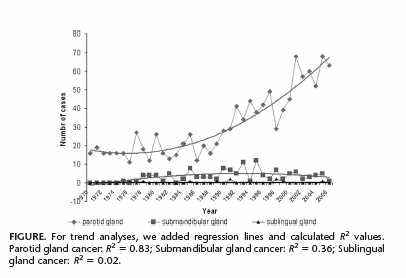Gsm / smartphone
Opvallende toename speekselklierkanker laatste 10 jaar
- Gegevens
- Gepubliceerd: vrijdag 24 december 2010 10:07
Stopumts.nl - In een brief aan het tijdschrift Epidemiology schrijven de onderzoekers Czerninski en Zini over de verontrustende stijging, vooral na 2001, van speekselklierkanker onder de bevolking van Israël. De onderzoekers stellen dat dit mogelijk te wijten is aan de enorme toename in gsm-gebruik.

Bron: Epidemiology: January 2011 - Volume 22 - Issue 1 - pp 130-131
Risk of Parotid Malignant Tumors in Israel (1970–2006)
Czerninski, Rakefet; Zini, Avi; Sgan-Cohen, Harold D.
Department of Oral Medicine, Hebrew University-Hadassah School of Dental Medicine, Jerusalem, Israel, rakefetc [at] hadassah.org.il (Czerninski)
Department of Community Dentistry, Hadassah School of Dental Medicine, Hebrew University, Jerusalem, Israel (Zini, Sgan-Cohen)
To the Editors:
Major salivary gland cancers are rare and with few known risk factors. We have analyzed the incidence and epidemiologic features of major salivary gland cancer (ICD.C07–C091) using data from the Israel National Cancer Registry, 1970–2006.
The annual incidence of major salivary gland cancer was 0.8 cases per 100,000. The most common subtype of salivary gland tumor was salivary gland carcinoma (60% of all cases) followed by squamous cell carcinoma (18%) and lymphoma (10%). Of 1924 cases (1039 men, 885 women), 60% were in the parotid gland, 7% in the submandibular gland, and fewer than 1% in the sublingual gland; the remaining 33% were recorded as overlapping or not otherwise specified (ICD.C 08.8, 08.9).1 Our results for sex, age, site, tumor type, and rate per year are similar to those reported in the literature. Comparing the parotid gland tumors with all other salivary gland locations, there were no important differences in risk by sex, age, or ethnicity.
Trends for parotid gland cancers have seldom been reported, and have not been compared with other types of salivary gland tumors. The total number of parotid gland cancers in Israel increased 4-fold from 1970 to 2006 (from 16 to 64 cases per year), whereas other major salivary gland cancers remained stable (Fig. 1). The steepest increase occurred after 2001, with an average of 37 cases of parotid gland cancer annually before that date and 61 cases per year subsequently. The distribution of cases by age, sex, or tumor type did not change substantially during this time. The population of Israel increased 2.1-fold from 1970 to 2001, but only 1.1-fold from 2001 to 2006.2 Population growth could not, therefore, explain the increased number of parotid gland cancers.
The proportion of major salivary gland cancers "not otherwise specified" declined from 36% before 2001 to 13% during 2001–2006. This shift may have contributed to changes over time in specific diagnoses. Nevertheless, even if we assume that all cases not-specified were parotid gland cancers, there remains a substantial increase of parotid gland cancers with time (72 cases per year after 2001 compared with 44 cases per year before).
Published data have suggested possible etiologies for major salivary gland cancers, including exposure to radiation (therapeutic and diagnostic), aging, and other factors.3–5 The marked increase of parotid gland cancers in the last decade may reflect differences in an external risk factor specific to the parotid region. The INTERPHONE study (6) has investigated parotid gland tumors and other tumors that originate in tissues most exposed and proximal to cellular phones. Israelis are heavy users of cellular phones, with a 6-fold increase in usage (by minutes) from 1997 to 2006.7,8 Investigators have previously suggested a potential association of parotid gland tumors with cell phones in an Israeli case-control study.7
Data on individual exposures to cell phones are not available in the registry data, and no causal association with parotid malignant tumors can be ascertained from these ecologic data. Further research is required to investigate the spectrum of possible etiological factors.

rakefetc @ hadassah.org.il
Avi Zini
Harold D. Sgan-Cohen
Department of Community Dentistry
Hadassah School of Dental Medicine
Hebrew University
Jerusalem, Israel
Voor de oorspronkelijke brief met grafieken zie hier
Voor een begeleidend commentaar van Microwave News zie hier


